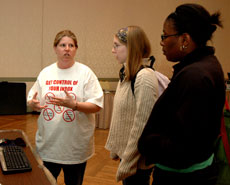CITES introduces program

CITES employee Leslie Ranking shows Catherine Brickell, sophomore in LAS (left), and Vincentia Egonmwan, senior in applied life studies, how to sign up for CITES´ spam block service in the Illini Union on Thursday. The service currently blocks unwan Vadim Olden
April 29, 2005
Campus Information Technologies and Educational Services (CITES) held the Spring Computer Security Day Thursday to assist students, faculty and other University account users in using a new program that allows University e-mail account users to block unsolicited messages called “spam.”
Mark Hart of the CITES security office said that approximately fifty percent of the e-mail messages sent through the University on a daily basis are spam. Within the last week, 2.8 million e-mails have been flagged as certain or likely spam, he said.
During Thursday’s event, held at Illini Union Room C from 10 a.m. to 3 p.m., CITES employees provided assistance to those who wanted to start using the free program.
Elizabeth King, a junior in LAS, signed up to use the program during the CITES’ event. She said she had recently checked her account that morning, and had received six or seven spam e-mails.
“I was like ‘hey this is perfect,’ ” King said. “I think it will save me a lot of time. It will save me space in my inbox.”
Get The Daily Illini in your inbox!
Leslie Rankin, security support specialist for CITES, said responses to the spam blocker have been positive.
“Everybody that has signed up has been thrilled,” Rankin said. “I have gotten so many thank-you e-mails. I’ve been here 22 years and this is the most thank-you’s I’ve ever gotten. I even got one marriage proposal.”
The way the spam control works is simple, Rankin said. Users have four options for handling their spam. The program was officially introduced about three weeks ago, and everybody has slowly been added automatically into the “tag and deliver” personal spam policy (PSP), she said.
After signing up to use the spam blocker, users are automatically signed up for the “cautious” PSP, where certain and likely spam is sent to quarantine and no messages are deleted. An “aggressive” PSP and “no quarantine” PSP are also offered. Aggressive spam-control deletes certain spam, while likely spam is sent to quarantine.
“A lot of people tell me (the program is) underwhelming,” Rankin said, after hosting more than 10 demonstrations of the program across campus. “And it’s like ‘that’s what we wanted!’ Simple. Not too many options. We just wanted (users) to have (their) time back.
“I really think this is going to give everybody back a half an hour of their day that they are now spending deleting junk out of the e-mail inbox,” Rankin said.
The process of choosing the right program took approximately a year to complete. Rankin said a test group of 113 people – most of whom had no technical knowledge of the system – were required to evaluate different programs for about six weeks.
“It was a real broad base of people who could provide us valid information on what average users want,” Rankin said. “Ease of use was critical.”
“I was in the pilot study,” said Ivy Glennon, director of advising in advertising and media studies. “(The spam-control) is absolutely necessary.”
Glennon said she is happy with the way the new program works. She said it has only misidentified one or two e-mails as spam in the six weeks she has had it.
Users may change their settings at any time, including the aggressive PSP if they do not want to check the end user digest while on vacation, Rankin said.
According to the CITES Web site, everyone on campus should be contacted via e-mail to notify them of the new program by the middle of May. But training sessions hosted in May will allow users to start early. Users may also sign up for the program simply by going to the CITES Web site and following the links. Rankin said no downloading of any kind is necessary.
But Rankin cautioned that it is important to realize the new spam-control, for all of its simplicity and effectiveness, is not perfect.
“The product is really smart,” Rankin said. “It knows what spam is. (But) if you get 200 spams a day, you might have one or two sneak through.”






